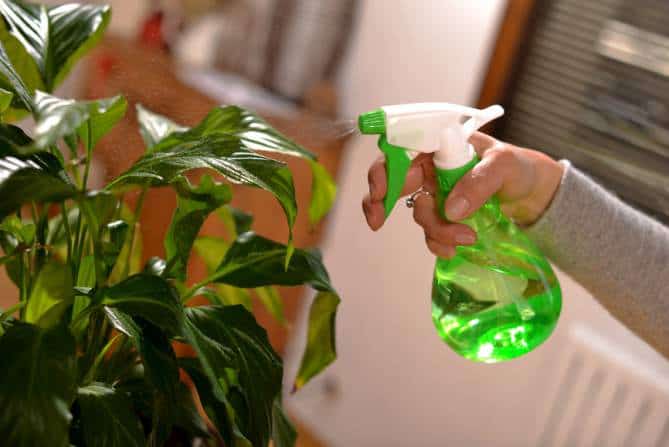Besides the increasingly serious air pollution, indoor pollutants from carpets, fibers, asbestos, smoke, dust, and bacteria also contribute. part of our own health. Growing indoor plants can contribute to eliminating harmful gases and filtering fine dust in the air. Some ornamental plants have a reverse biological mechanism that absorbs carbon dioxide and provides oxygen day and night for humans, improving our sleep.
Ornamental plants placed indoors will require different care than ornamental plants placed outdoors or in garden soil. Because of factors such as light, the humidity will be different, so the care of indoor bonsai will also be more sophisticated. In this article, we will share with you 8 ways to take care of and protect indoor plant decor so that they stay green and grow well.

1. Ensure adequate light for plants to grow.
To take care of indoor plants, the first factor you need to pay attention to is light. So what is the right light for plants to grow in? Depending on the characteristics of each plant, the amount of light will vary. There are ornamental plants that tolerate low light, but there are ornamental plants that need natural light to grow.
However, even if the plants have low light tolerance, they still need to ensure adequate light for the plants to grow. If you are going to put a bonsai in your living room, make sure it gets at least 2-3 hours of natural light. Or you should put the plant in the sun for 2-3 hours a week to let it grow naturally.
Ensure adequate light for plant growth.
“Strong” light usually appears in front of south-facing windows or large east or west windows that are unobstructed. Small, unobstructed east or west windows provide “medium” light. The north window and those with frosted glass provide only “low” light. Your plants will only receive low light if they are more than 2 meters away from a window in any direction.
In addition, many families also use more light emitted from lamps, like sunlight, so the plants can photosynthesize like the outside environment and grow better.
2. Provide just the right amount of water for indoor plants.
The second factor to keep in mind when taking care of indoor plants is the amount of water. Usually, houseplants should not be watered too much. When you see that the soil is dry, it should be watered.
In addition, when watering plants, you should use a spray bottle to spray the plants. In the summer, it should be sprayed twice a day and once a day in the winter to increase moisture, clean the leaves, benefit the plant’s photosynthesis, and make the plants green.
Water tolerance varies depending on the type of plant, as does the amount of water required for growth. You can choose the right potted plants; you can use bonsai pots with discs underneath for easy movement and good drainage that does not leak water into the house.
3. Nutritional supplements for indoor plants
The appropriate amount of fertilizer for indoor-grown ornamental plants will help promote plant growth. If you apply too much fertilizer, the plant will grow quickly, lose its shape, and destroy its position. It even kills the tree.
However, if too little is applied, the plant will suffer from a lack of nutrients, difficulty growing, and dead branches. As a result, the best method is to fertilize the tree once every half month with 5% synthetic fertilizer. In addition, using rice water to water plants is also very good for the growth of plants.
Indoor plants limit the use of pesticides because they will affect your own health. So if the plant shows signs of pests, you should first use alcohol to wipe the leaves and roots, then use organic drugs to control pests.
4. Increase the humidity in an air-conditioned home or office.
Dry air can be good for some drought-tolerant plants like cacti, but most houseplants need moisture, especially tropical plants. You can buy a cool mist room humidifier and place it close enough to the plant to provide moisture in the air without wetting the foliage or flowers. Another way is to use a spray bottle and mist the plants every day to keep them moist. Planting potted plants close together also causes them to add moisture to the air to provide mutual support.

5. Regularly prune and clean indoor plants.
When taking care of indoor plants, it is important to pay attention to regular pruning. Trim the roots so that the roots do not outgrow the pot, causing the pot to crack. Pruning leaves and dense or wilted branches keep the tree clean and elegant while also keeping insects at bay. Pruning old branches also helps promote plant growth.
Along with pruning, pay attention to using a soft cloth to wipe away dirt and dust (by the air purifier) so that the tree is always green and grows better. Remember to wear gloves when fertilizing, pruning, or wiping leaves!
6. Take timely measures to restore plants when they are dry.
When plants are found to have yellowing, withering, and dropping leaves, they must take timely measures. Take care of the tree to restore its vitality.
Do not allow direct sunlight to irradiate the plants to avoid making the heat of the sun adversely affect the plants or possibly causing the plants to die due to dehydration. The place to take care of the plant should be a cool place with fresh air and should be protected from strong winds.
During the first period of plant growth, the soil should not be affected because at this time the organization and function of the tree are in a static state. If the ground is broken, this will cause damage to the plant’s root system.
At this time, you should only cut off the yellow, withered leaves, and water fully, and at the same time, you can mix nitrogen in water with a low concentration to water the plants once a week. After each month, it will gradually increase. volume; after about 2-3 months, the concentration will increase.
7. Keep children and pets away from plants.
Indoor plants are potentially dangerous for pets or children to attack. Many animals, such as cats, dogs, and rabbits, often gnaw on leaves or scratch the scattered potting soil, knocking the plants over. Young children often use scissors or their hands to cut and break leaves and branches. When growing ornamental plants in the house, you need to pay attention to protect the plants from these objects.
At the same time, many ornamental plants can be grown indoors, but in their stems, leaves, roots, or flowers there is a poison that causes burning or poisoning if touched or mistakenly eaten. You need to keep the plant away from pets or small children to protect them from poisoning.
8. Replanting annual plants
Replanting annual plants is also a way to take care of indoor plants that you should pay attention to. The tree was replanted because it was too big for the pot. You should replant the tree at least once a year. The right time to replant is in the spring or early summer when the weather is favorable.
When removing the plant from the pot, shake it vigorously so that the old soil falls off the roots. If the root ball is too tight and cannot be lifted, use a large knife to squeeze the soil close to the side of the pot and to the bottom of the pot. After lifting the plant out, add new soil to the bottom of the pot. Place the plant back in the pot and add new soil around the pot. Each type of plant is suitable for different types of soil, so you should pay attention to find out before you pot it.









